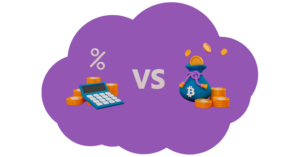
What is the Annual Percentage Rate (APR)?
The Annual Percentage Rate (APR) is the yearly interest that’s charged to borrowers or paid to investors expressed as a percentage. It represents the actual yearly cost of funds for a loan term or the income earned on an investment. It includes all fees or additional costs related to the transaction, but it doesn’t consider compounding.
The APR gives consumers an overall number that they can compare when evaluating lenders, credit cards, or investment products. This means that it provides a clear indication of the total cost of borrowing or the potential return on an investment over a year.
The calculation formula for the Annual Percentage Rate (APR):
APR = Periodic Rate x Number of Periods in a Year.
For example, if the periodic rate is 1% per month, then the APR would be calculated as follows: APR = 1% x 12 (since there are 12 months in a year) APR = 12%.
It’s important to note that APR does not indicate how often the interest rate is applied to the balance.
What is the Annual Percentage Yield (APY)?
The Annual Percentage Yield (APY) is the actual rate of return that you earn on your investment. It considers the effect of compounding interest, which is when interest is calculated periodically and added to your balance immediately. As your account balance grows with each period, the amount of interest paid on your balance also gets bigger.
To calculate the APY, you would use the formula:
APY = (1 + Periodic Rate)^Number of Periods – 1.
For example, let’s say you invest $10,000 in a savings account that earns 2% interest annually, compounded monthly. To calculate the APY, you would use the formula: APY = (1 + 0.02/12)^12 – 1 = 0.0202 or 2.02%.
This means that over the course of a year, you would earn $202 in interest on your $10,000 investment. Remember that APY considers any fees associated with the investment, so it can give you a more accurate picture of your earnings.
Accounts with APR vs. Accounts with APY
Financial products and accounts use either APR or APY, which have different meanings. It’s important to know which one is used for the account you’re considering. Here are some common examples:
APR accounts:
- Credit cards;
- Personal loans;
- Auto loans;
- Mortgage loans.
APY accounts:
- High-yield savings accounts;
- Money market accounts;
- Certificates of deposit (CDs);
- 401(k) accounts;
- 529 accounts;
- Bonds.
APR vs APY: Comparison
| Criteria | APR (Annual Percentage Rate) | APY (Annual Percentage Yield) |
| Compounding | Represents the yearly interest rate charged on a loan or earned on an investment. | Represents the yearly interest rate charged or earned on a loan or investment, factoring in compounding. |
| Calculation | Does not consider compounding, which is the interest earned on the interest. | Consider the effect of compounding, which means the interest earned on the interest is included in the calculation. |
| Usage | Provides consumers with a bottom-line number to compare different loan or investment products. | Provides a more accurate picture of the true cost of borrowing or potential return on an investment. |
| Fees and Costs | Includes all fees and costs associated with the loan or investment. | Includes all fees and costs associated with the loan or investment. |
| Actual Amount | The actual amount paid or earned may be higher than the advertised APR due to compounding. | The actual amount paid or earned may be higher than the advertised APY due to fees or other factors. |
| Calculation Method | Calculated by multiplying the periodic rate by the number of periods in a year. | Calculated by taking into account the interest earned on the principal and interest earned on the interest. |
| Comparison Use | Used to compare loan products and credit cards. | Used to compare savings accounts and investment products. |
Note: This table is a general overview of the differences between APR and APY and may not cover every scenario or financial product. It’s important to consult with a financial advisor or lender when making financial decisions.
APR vs. APY: Which Is Better?
The Borrower’s Viewpoint
You always want to pay the lowest possible interest rate when borrowing money. However, it’s essential to understand the difference between APR and APY. APR only considers the periodic interest rate multiplied by the number of periods in a year and does not assume any compounding of interest during that time. On the other hand, APY factors in the frequency of compounding interest, providing a more accurate representation of the actual annual cost of borrowing.
Let’s say you’re in the market for a loan, and a lender offers you an APR of 5%. However, the loan compounds monthly, and when you calculate the APY, the actual annual cost of borrowing is 5.11%. As you can see, the difference may seem small, but it can add up over the life of the loan.
To understand this better, let’s look at a new table:
APR vs. What You Actually Pay
| Quoted APR | Semi-annual | Quarterly | Monthly |
| 5% | 5.06% | 5.09% | 5.11% |
| 7% | 7.12% | 7.19% | 7.23% |
| 9% | 9.20% | 9.30% | 9.38% |
As you can see, the difference between APR and APY can be significant, particularly over a longer loan term. Therefore, it’s essential to ask your lender about the compounding frequency of the loan and the APY to ensure you’re getting the best possible deal.
The Lender’s Viewpoint
Imagine you want to open a savings account with a bank. Of course, you want the bank to pay you the highest interest rate possible on your savings. But, just like you want to pay the lowest interest rate possible when you borrow money, banks want to pay the lowest interest rate possible when they lend money or invest funds.
Banks may advertise their savings account rates using a number called APY, which includes compound interest and sounds more attractive than APR, which doesn’t include compounding. However, you need to pay attention to how often the interest is compounded and compare that to other banks’ APY quotes that compound at the same rate. The compounding frequency can significantly affect how much interest your savings will earn.




